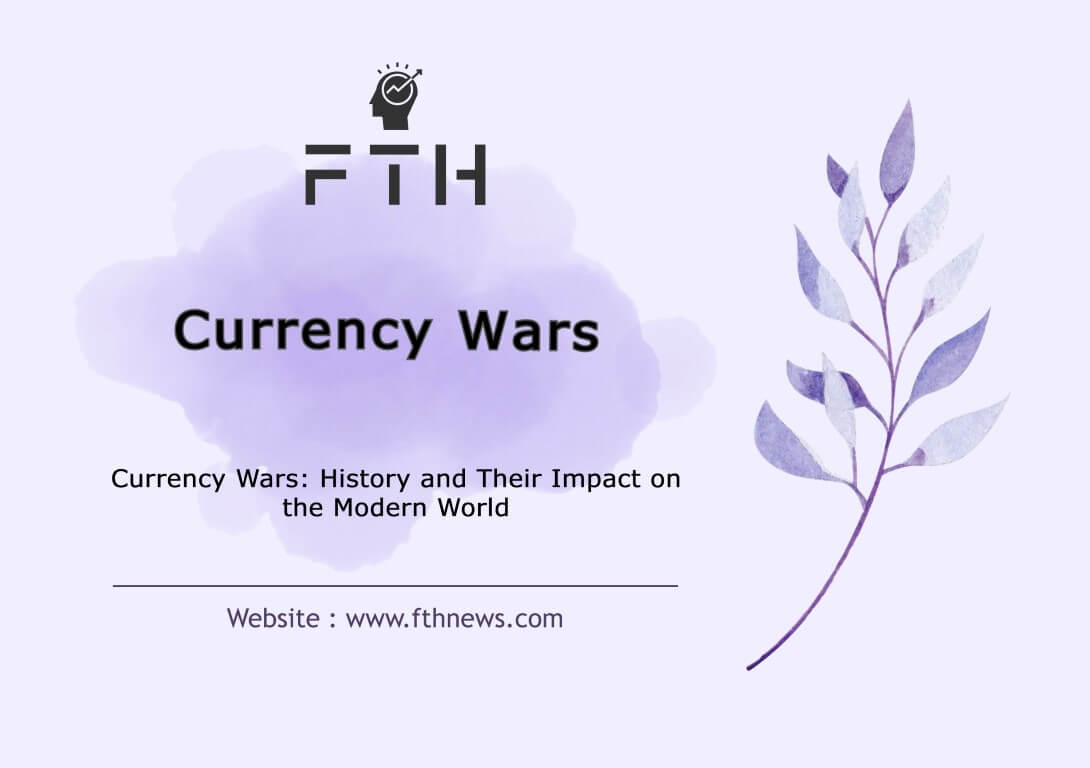
Currency Wars: Understanding the Past, Present, and Mechanics
Currency Wars In the annals of economic history, the rise and fall of currencies is a recurring saga. These monetary units embark on a journey through the cycles of growth, prosperity, and decline, and they are never solitary travelers on this path. The ordinary citizens of societies bear the brunt of these currency fluctuations, enduring the consequences of their nation’s monetary choices.
In this series, we delve into the book “Currency Wars” by the acclaimed author, James Rickards. Within the pages of this illuminating work, we explore the profound impact of currencies on individuals, nations, and entire economies. Join us on this captivating journey as we navigate the complex world of financial systems and their consequences.
What Is a Currency War?
A currency war happens when multiple countries all try to make their money worth less at the same time. They do this to make their products cheaper and more attractive to other countries. It’s like a competition to see who can have the weakest currency.
Currency War: The Dollar on a Precarious Edge?
The dollar, like all currencies throughout history, has weathered its fair share of highs and lows. From the early days of the first independent American government to the Nixon-era departure from the gold standard, and the crises of 2000 and 2007, each of these events has played a pivotal role in shaping the dollar’s trajectory. Today, the dollar, which underpins the economic and security foundations of both the United States and countries interconnected through its use, finds itself teetering on the precipice of decline, courtesy of inflation and the Federal Reserve’s monetary policies. In simple terms, the world stands on the brink of currency wars.
Understand a Currency Wars?
A currency war begins when a country intentionally devalues its currency to boost its export volume. In doing so, it effectively brandishes an economic sword not only against neighboring nations but also against countries far beyond its borders. China, in particular, has faced repeated accusations of manipulating its currency’s value, exporting goods at remarkably low prices.
The ripple effects of China’s economic influence extend to markets in countries both near and far, often leading to the closure of domestic factories. Nevertheless, the story of currency wars is far more intricate than it may seem.
You might wonder why certain countries, rather than following the conventional path to economic growth and stability, opt for dangerous strategies like currency wars, inadvertently leading other nations into turbulent economic waters.
The answer lies in the circumstances of nations facing economic turmoil, poverty, heavy debt burdens, underdeveloped infrastructure, and a lack of coherent economic growth strategies. For them, devaluing their currency and increasing exports may appear as a desperate lifeline. However, in doing so, they resemble a drowning person who pulls others underwater in an attempt to save themselves, causing severe damage to the semi-healthy or even robust economies of other nations worldwide.
Do Weak Countries Truly Overcome Challenges by Devaluing Their Currency?
The straightforward answer to this question is a resounding “no.” On the surface, it might appear that devaluation is a magic bullet that leads to improvements: increased employment opportunities, a surge in foreign currency inflow, and economic growth.
All these outcomes seem to be the result of abundant and attractively priced exports. However, behind the scenes, the story is more intricate.
The export process is not a simple equation of devaluation equals prosperity. Successful export-driven growth hinges on the ability to manufacture and produce goods efficiently.
And for production, one invariably needs raw materials. Even a formidable economic power like China, which has pivoted toward low-cost exports, distributing its products far and wide, is heavily reliant on importing raw materials from other countries to create those very goods.
It’s an inescapable reality. This underscores the interconnect of the world’s economies. China, as one of the largest exporters of a wide range of products to the United States, also ranks as one of the largest purchasers of steel and mineral resources from other nations.
This symbiotic relationship reminds us that we share a common planet, transcending the artificial borders we’ve drawn on maps. We are all part of a global family, interconnected in ways we might sometimes overlook. Our actions, whether on a grand or modest scale, have far-reaching implications, as we depend on one another for a multitude of resources and economic interactions.
The Genesis of Currency Wars: Germany’s 1921 Prelude
The inaugural chapter of currency wars sounded in Germany in 1921. It was during this tumultuous period that the German central bank embarked on a relentless journey of money printing, culminating in what is now known as “hyperinflation.” Germany’s motive behind this reckless monetary policy was to address its mounting government budget deficit and find a way to settle its crippling debts.
Initially, the general populace, factory owners, and government employees didn’t grasp the full extent of the impending danger posed by this inflation. Prices were indeed rising, but it wasn’t yet considered a catastrophic scandal.
However, within the span of a year or two, the situation took a drastic turn. Those who had entrusted their savings to banks found themselves in dire straits as the German mark rapidly lost its value. Shareholders, property owners, and individuals who had wisely converted their savings into gold fared somewhat better in this turbulent financial climate.
As the crisis deepened, Germany’s response was to ramp up money printing, pushing the boundaries of fiscal irresponsibility. In an astonishing turn of events, even the central bank resorted to utilizing private companies’ printing presses for this purpose.
Adding to the chaos, war-torn countries seeking reparations from Germany relentlessly demanded payment. However, the dramatic depreciation of the German mark made it nearly impossible for Germany to meet these financial obligations.
Unsurprisingly, some nations, including France and Belgium, couldn’t wait any longer. They initiated acts of economic aggression, targeting German industries, and essentially held German goods and resources hostage as a form of reparations.
First Currency Wars: Political Ends Over Economic Means
It’s worth noting that many currency wars are not waged solely to achieve economic objectives but are driven by political agendas. Germany’s foray into devaluing its currency during the early 1920s is a stark example of this.
The German government’s primary goal was to rebuild its political relationships with powerful nations such as the United States and England, a goal it ultimately achieved. However, this approach had a significant drawback – it left thousands of families and citizens struggling to put food on the table, and some may have even perished as a result.
Once Germany reached its political objectives through currency manipulation, it took roughly three years to regain control of the situation and kick start its production engine at full throttle.
This strategy left a lasting impression on other nations, many of which have since employed similar tactics within their own borders. However, it’s crucial to recognize that in the midst of these economic maneuvers, it’s the ordinary people of society who often bear the brunt of these actions. They find themselves caught in the crossfire, whether facing the repercussions of economic turmoil or grappling with the challenge of putting food on their tables.
Gold Exchange Standard: A Delicate Balancing Act
Let’s rewind the clock a few years prior to Germany’s economic collapse to the year 1913. It was during this period that the United States ushered in a new era of monetary management by establishing its central bank, the “Federal Reserve.” As the German currency plummeted in value over the ensuing years, nations worldwide, including the United States, convened at the “Genoa” conference to make a momentous decision. Based on the agreements reached at this conference, countries globally returned to the “gold standard,” but it wasn’t quite the same old standard. A new framework was introduced, known as the “gold exchange standard.”
What makes this standard particularly intriguing is its approach to considering foreign currencies as if they were gold. In simpler terms, the central banks of different countries could use foreign currencies as the foundation for their monetary systems. On the surface, this arrangement appeared sensible and well-founded, but in essence, it was akin to constructing a house on a foundation of water. If a nation’s currency, of which trillions were held in the central banks of other countries, suddenly lost its value a fate similar to what befell Germany’s mark – it would spell triumph for that country’s economy.
When Major Nations Ponder a Global Monetary Order
In the wake of the World Wars and the gradual recovery of the global economy, the Allied nations—specifically, those with significant economic might—came together to reflect on past economic crises and devise a new framework for the world economy. This newly established system ushered in an era of currency and economic stability that endured for three decades. At the core of this system was the U.S. dollar, which was pegged to gold and served as the linchpin for international trade.
The Allies collectively agreed not to devalue their currencies without mutual consent, save for those nations experiencing severe economic distress. Additionally, they founded the “International Monetary Fund” (IMF) to provide financial assistance to countries grappling with budget deficits. However, this period of harmony and cooperation didn’t last as long as initially hoped and ultimately suffered disruption, partly due to the actions of the United States, one of the central pillars of this international financial system.
America’s Struggles Within the System It Forged
This conundrum can be attributed to two key factors:
- Intensification of the Vietnam Conflict
- The American Anti-Poverty Program
The first factor led to a significant increase in war costs, while the second factor entailed growing government expenditures over an extended period. These developments fueled the flames of inflation and gradually eroded the value of the U.S. dollar. Much like the German populace before their currency’s hyperinflation, the American people observed rising prices but couldn’t foresee that it would eventually deplete their savings and devalue their other assets. The United States projected a formidable image to the world, masking the concerns of its statesmen who grappled with these challenges behind the scenes.
England’s Catalyst: The Prelude to Currency Wars
While Britain was a steadfast ally of the United States within the newly established monetary system, events took an unexpected turn in 1967 when a financial crisis intensified.
The British government, without securing permission from the United States, opted to devalue the pound. Two critical factors contributed to the pound’s entanglement in the financial turbulence of those years. The first was the “disparity in the pound’s value across different nations,” and the second was the “insufficiency of British gold reserves to back these paper assets.” England’s bold move set a precedent, empowering other member nations of the new monetary system to manipulate their currency values similarly.
Amidst this upheaval, the United States held an ace up its sleeve by anchoring the dollar to gold.
The Currency Wars of Our Time
Today, we witness a new chapter in the annals of currency wars, where the dominant players are the “dollar,” “euro,” and “yuan.”
While other currencies participate in this arena, it’s the sheer scale of transactions involving these three global currencies that positions them at the forefront of this battle. Some economists argue that this third currency war surpasses its predecessors in magnitude, with no guarantee that it won’t recur in the future.
The signs of this conflict manifest as inflation, deliberate currency devaluations, spikes in unemployment, and more. Remarkably, the dollar is omnipresent on all fronts of this battle, whether facing off against the yuan or aligning with the euro. The struggle for currency supremacy persists, shaping the financial landscape of our era.
The Dollar-Yuan Clash: Currency Wars
For several decades, China appeared largely indifferent to its own economic growth and development. The Communist People’s Government of China worked diligently to suppress its domestic market and any signs of progress. However, a realization slowly dawned upon them—this approach was unsustainable.
It marked the beginning of a remarkable transformation in the Chinese economy. The Chinese government recognized the need to enhance the country’s infrastructure and generate employment opportunities for millions of its citizens. To achieve these ambitions, the only viable path was to embark on large-scale exports to the global market.
In pursuit of this goal, China began to manipulate the value of the yuan, setting the stage for extensive and affordable exports to the world. The initial nonchalance of America and Europe toward China’s actions soon gave way to a sobering realization.
China’s currency manipulation directly influenced the economies of the United States, Europe, and indeed the world, as it propelled China’s rise on the global stage.
The United States repeatedly implored China to cease its currency devaluation practices, to no avail. Concurrently, domestic tensions in China escalated, and the government’s use of force against its own citizens provided the U.S. with grounds for imposing economic sanctions. However, a peculiar turn of events occurred later when the terrorist attacks of “Al-Qaeda” shook the United States. In a rather unusual twist, relations between China and the United States improved significantly. This was largely due to China aligning itself with the United States in the global fight against terrorism.














